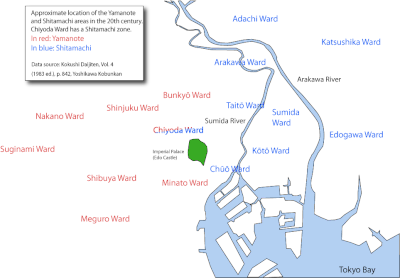
Yamanote and Shitamachi today. Yamanote marked in red and Shitamachi in blue letters.
Yamanote (山の手) and Shitamachi (下町) are traditional names for two areas of Tokyo, Japan. Yamanote refers to the affluent, upper-class areas of Tokyo west of the Imperial Palace.[1][2] While citizens once considered it as consisting of Hongo, Kōjimachi, Koishikawa, Ushigome, Yotsuya, Akasaka, Aoyama and Azabu in the Bunkyō, Chiyoda (in part), Shinjuku, and Minato wards,[1] its size has grown to include the Nakano, Suginami and Meguro wards.[1山手(山の手)和下町(下町)是日本東京兩個地區的傳統名稱。 山手指的是東京皇宮以西的富裕上流社會地區。 [1][2] 雖然市民曾經認為它由文京區、千代田區(部分)、新宿區和港區的本鄉、麴町、小石川、牛込、四谷、赤坂、青山和麻布組成,[1] 但它的規模已經擴大到包括中野區 , Suginami 和 Meguro 病房。
Shitamachi is the traditional name for the area of Tokyo including today the Adachi, Arakawa, Chiyoda (in part), Chūō, Edogawa, Katsushika, Kōtō, Sumida, and Taitō wards, the physically low part of the city along and east of the Sumida River.[2][3]
下町是東京地區的傳統名稱,包括今天的足立區、荒川區、千代田區(部分)、中央區、江戶川區、葛飾區、江東區、墨田區和台東區,以及墨田區和墨田區以東的地勢較低的地區 河流[2][3]
***
初四感時之後可以談談川上弘美Hiromi Kawakami ( 1958年~ )的Tokyo Reading List....Read Your Way Through Tokyo
感時:何日君再來?積蓄成空中樓閣;美國:機密文件不歸路;ˊ‘Tragedy Upon Tragedy’: 加州春節槍殺;紐約藝術之都.....
https://www.facebook.com/hanching.chung/videos/862344611683586
Ben Chen
位於冷僻深山村落
米其林二星餐廳
富山縣利賀村
離東京車程5小時
需要半年前預約
有客戶專程開露營車過來
12道 set menu 日幣 $22,000鄭 清茂翻譯的《輓歌》 ; 《新建築》;伊斯坦的寺廟建築
日本漫遊:: 日本北海道自由行-阿寒湖溫泉-阿寒摩周國立公園
https://www.e-japannavi.com › hokkaido › akanko01
阿寒湖。阿寒湖溫泉。日本北海道阿寒湖旅遊。北海道道東。北海道阿寒湖旅遊景點。阿寒湖距離札幌車程約230km,是北海道著名的景點,是15万年前火山噴發後形成的北海道 ...
日本消失的三十年
寒流
博物館
大眾文化
動畫
書
電影
周作人與鮑耀明通信集(1960-1966)
,鮑耀明翻譯過
永井荷風的名作『濹東綺譚』,可惜不知道該書細節。“A Strange Tale from East of the River,” Kafu Nagai
Hiromi Kawakami’s Tokyo Reading List
“The Narrow Road to the Deep North,” Matsuo Basho
Matsuo Basho was born in the mid-17th century and spent his life as a wandering poet. Many of his journeys are collected in various travelogues, but “The Narrow Road to the Deep North” (also translated as “The Narrow Road to the Interior”), written toward the end of his life, remains beloved in Japan and has been translated into many languages./The book is the record of a five-month, 1,500-mile journey on foot, which started in Edo and wound its way throughout the vast northern territories of the Tohoku and Hokuriku regions. Setting out from Senju, on the banks of the Sumida River, in present-day Sumida-ku, Basho composed this haiku: Departing spring, birds cry out, tears in the eyes of fishes./
“The Curious Casebook of Inspector Hanshichi,” Kido Okamoto
“The House of Nire,” Morio Kita
“Ten Nights’ Dreams,” Natsume Soseki 夏目漱石
夢十夜
“A Strange Tale from East of the River,” Kafu Nagai
“A Strange Tale from East of the River,” Kafu Nagai
“Seventeen,” Kenzaburo Oe 大川健三郎
日比谷三島由紀夫の自決を受けてすぐに、天皇制を批判的に問い直す「みずから我が涙をぬぐいたまう日」を書いている。その後も三島事件は『新しい人よ眼ざめよ』(1983年)連作の「落ちる、落ちる、叫びながら…」「蚤の幽霊」、『さようなら、私の本よ!』(2005年)と繰り返し取り上げられる。大江がかつて天皇崇拝のテロリストの少年を描いた「セヴンティーン」を発表した際、それを読んだ三島は、大江は国家主義に情念的に引きつけられるところがある人間なのではないか、と考えて『新潮』の編集者を介して大江に手紙をよこしたという。2007年のインタビューで大江は、三島の読み取りは正しく、自分の中にアンビバレントなものがあることを認めている[118]。
“Toddler Hunting and Other Stories,” Taeko Kono
“The Woman Next Door,” Kuniko Mukoda 向田邦子
- "Meeting Again" 再会 (Saikai) in Tokyo stories: a literary stroll, Lawrence Rogers (ed.), University of California Press, 2002
- 西武スペシャル『隣りの女 現代西鶴物語』(1981年、TBS)向田邦子
“After the Quake,” Haruki Murakami 村上春樹

村上朝日堂
“The Book of Tokyo,” edited by Jim Hinks, Masashi Matsuie and Michael Emmerich
Hiromi Kawakami is one of Japan’s most popular contemporary novelists. She has won numerous literary prizes in Japan and the United States, including the Akutagawa Prize for “A Snake Stepped On” and the Tanizaki Prize for “Strange Weather in Tokyo.”
Allison Markin Powell is a literary translator based in New York City who has translated Osamu Dazai and Kaoru Takamura, and whose translation of Kawakami’s “The Ten Loves of Nishino” won the 2020 PEN America Translation Prize.
The Ten Loves of Mr Nishino
Hiromi Kawakami
Translated by Allison Markin Powell
Over the course of his life, Mr Nishino falls hopelessly in love again and again. One woman is a colleague, another a chance encounter; one is the girlfriend of a classmate, another the best friend of Nishino’s latest conquest. Some are entranced by Nishino, others care more for their freedom, their children (or their cats).
As we come to learn of the torments, desires and delights of each woman, a portrait emerges of a complicated man whose great capacity for love may well be the cause of his downfall.
****
Tokyo stories: a literary stroll
 | |
| Authors | Translated and edited by Lawrence Rogers |
|---|---|
| Cover artist | Frances Baca |
| Country | United States |
| Language | English |
| Published | 2002 (University of California Press) |
| Media type | |
| Pages | 267 pp |
| ISBN | 0520-21788-8 |
Tokyo Stories: A Literary Stroll is an anthology of Japanese short stories set in Tokyo.[1] The translator and editor Lawrence Rogers won the Japan-U.S. Friendship Commission Prizes for the Translation of Japanese Literature from the Donald Keene Center of Japanese culture in 2004.[2][3] The stories are ordered by the areas of Tokyo in which they take place.
Contents[edit]
Central Tokyo[edit]
- "Mire" by Motojiro Kaiji
- "Terrifying Tokyo" by Kyūsaku Yumeno
- "The Image" by Rintaro Takeda
- "Fountains in the rain" by Yukio Mishima
- "Meeting Again" by Kuniko Mukōda
- "Jacob's Tokyo Ladder" by Keizo Hino
Shitamachi[edit]
- "The Death Register" by Ryūnosuke Akutagawa
- "Kid Ume, the Silver Cat" by Yasunari Kawabata
- "The First Day of the Fair" by Rintaro Takeda
- "Elegy" by Ineko Sata
- "The Old Part of Town" by Fumiko Hayashi
- "Fireworks" by Yukio Mishima
- "Azuma Bridge" by Kafū Nagai
- "An Unclaimed Body" by Michiko Ikeda
West of the Palace[edit]
- "From Behind the Study Door" by Natsume Sōseki
- "Firefly Tavern by Kazuko Saegusa
- "Swallows" by Takehiro Irokawa
The South End[edit]
- "Morning comes twice a day" by Mayumi Inaba
沒有留言:
張貼留言